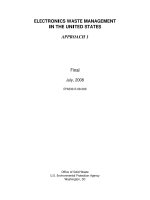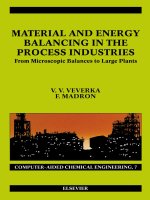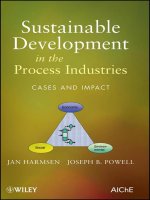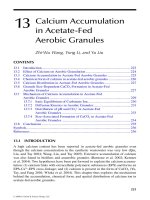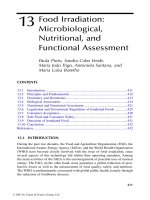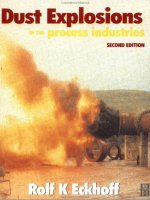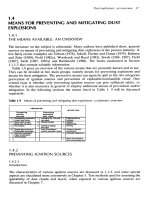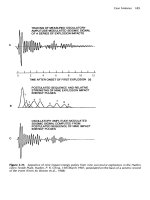Waste Treatment in the Process Industries - Chapter 13 (end) pot
Bạn đang xem bản rút gọn của tài liệu. Xem và tải ngay bản đầy đủ của tài liệu tại đây (425.02 KB, 41 trang )
13
Treatment of Power Industry Wastes
Lawrence K. Wang
Lenox Institute of Water Technology and Krofta Engineering Corporation, Lenox, Massachusetts
and Zorex Corporation, Newtonville, New York, U.S.A.
13.1 INTRODUCTION
13.1.1 Steam Electric Power Generation Industry
The steam electric power generation industry is defined as those establishments primarily
engaged in the steam generation of electrical energy for distribution and sale. Those
establishments produce electricity primarily from a process utilizing fossil-type fuel (coal, oil, or
gas) or nuclear fuel in conjunction with a thermal cycle employing the steam–water system as
the thermodynamic medium. The industry does not include steam electric power plants in
industrial, commercial, or other facilities. The industry in the United States falls under two
Standard Industrial Classification (SIC) Codes: SIC 4911 and SIC 4931.
There are about 1000 steam electric power generating plants in operation in the United
States. Of these plants, approximately 35% generate in excess of 500 megawatts (MW) and
approximately 12% generate 25 MW or less. These steam electric power generating plants
represent about 79% of the entire electric utility generating capacity, and they generate about
85% of electricity produced by the entire electric utility industry. Within the steam electric
power generation industry, plants built after 1970 represent 44% of the total capacity, and plants
built before 1960 represent 26% of capacity.
“Small units” are defined by the U.S. Environmental Protection Agency (USEPA) as
generating units of less than 25 MW capacity. “Old units” are defined as generating units of
500 MW or greater rated net generating capacity that were first placed into service on or before
January 1, 1970, as well as any generating unit of less than 500 MW capacity first placed in
service on or before January 1, 1974.
The term “10-year, 24-hour rainfall event” refers to a rainfall event with a probable
recurrence interval of once in 10 years as defined by the National Weather Service.
13.1.2 Power Generation, Waste Production, and Effluent Discharge
In the operation of a power plant, combustion of fossil fuels – coal, oil, or gas – supplies heat to
produce steam, which is used to generate mechanical energy in a turbine. This energy is
subsequently converted by a generator to electricity. Nuclear fuels, currently uranium, are used
in a similar cycle except that the heat is supplied by nuclear fusion wastewater discharge. A
number of different operations by steam electric power plants discharge chemical wastes. Many
wastes are discharged more or less continuously as long as the plant is operating. These include
581
© 2006 by Taylor & Francis Group, LLC
wastewaters from the following sources: cooling water systems, ash handling systems, wet-
scrubber air pollution control systems, and boiler blowdown. Some wastes are produced at
regular intervals, as in water treatment operations, which include a cleaning or regenerative step
as part of their cycle (ion exchange, filtration, clarification, evaporation). Other wastes are also
produced intermittently but are generally associated with either the shutdown or startup of a
boiler or generating unit, such as during boiler cleaning (water side), boiler cleaning (fire side),
air preheater cleaning, cooling tower basin cleaning, and cleaning of miscellaneous small
equipment.
The discharge frequency for these varies from plant to plant. Some or all of the various
types of wastewater streams occur at almost all of the plant sites in the industry. However, most
plants do not have distinct and separate discharge points for each source of wastewater; rather,
they combine certain streams prior to final discharge.
Additional wastes exist that are essentially unrelated to production. These depend on
meteorological or other factors. Rainfall runoff, for example, causes drainage from coal piles,
ash piles, floor and yard drains, and from construction activity.
The summary for the steam electric power generating (utility) point source category in
terms of the number of dischargers in industry is as follows:
. direct dischargers in industry: 1050;
. indirect dischargers in industry: 100;
. zero dischargers in industry: 10.
Current BPT regulations for the steam electric power industry for generating, small and
old units can be found elsewhere [1].
13.2 INDUSTRY SUBCATEGORY AND SUBDIVISIONS
Subcategories for the steam electric utility point source category are developed according to
chemical waste stream origin within a plant. This approach is a departure from the usual method
of subcategorizing an industry according to different types of plants, products, or production
processes. Categorization by waste source provides the best mechanism for evaluating and
controlling waste loads since the steam electric power plant waste stream source has the
strongest influence on the presence and quantity of various pollutants as well as on flow. The
breakdown of the stream electric power generation industry into subcategories and subdivisions
is based on similarities in wastewater characteristics throughout the industry. The eight broad
subcategories and their subdivisions are presented below:
1. Once-through cooling water.
2. Recirculating cooling system blowdown.
3. Ash transport water:
. fly ash transport;
. bottom ash transport.
4. Low volume wastes:
. clarifier blowdown;
. makeup water filter backwash;
. ion exchange softener regeneration;
. evaporator blowdown;
. lime softener blowdown;
. reverse osmosis brine;
582 Wang
© 2006 by Taylor & Francis Group, LLC
. demineralizer regenerant;
. powdered resin demineralizer;
. floor drains;
. laboratory drains;
. sanitary wastes; and
. diesel engine cooling system discharge.
5. Metal cleaning wastes:
. boiler tube cleaning;
. cleaning rinses;
. fireside wash; and
. air preheater wash.
6. Ash pile, chemical handling, and construction area runoff coal pile runoffs.
7. Coal pile runoff.
8. Wet flue gas cleaning blowdown.
13.2.1 Once-Through Cooling Water Subcategory
In a steam electric power plant, cooling water is utilized to absorb heat that is liberated from the
steam when it is condensed to water in the condensers. The cooling water is withdrawn from a
water source, passed through the system, and returned directly to the water source. Shock
(intermittent) chlorination is employed in many cases to minimize the biofouling of heat transfer
surfaces. Continuous chlorination is used only in special situations. Based on 308 data,
approximately 65% of the existing steam electric power plants have once-through cooling water
systems.
13.2.2 Recirculating Cooling Water Subcategory
In a recirculating cooling water system, the cooling water is withdrawn from the water source
and passed through condensers several times before being discharged to the receiving water.
After each pass through the condenser, heat is removed from the water through evaporation.
Evaporation is carried out in cooling ponds or canals, in mechanical draft evaporative cooling
towers, and in natural draft evaporative cooling towers. In order to maintain a sufficient quantity
of water for cooling, additional makeup water must be withdrawn from the water source to
replace the water that evaporates.
When water evaporates from the recirculating cooling water system, the dissolved solids
content of the water remains in the system, and the dissolved solids concentration tends to
increase over time. If left unattended, the formation of scale deposits will result. Scaling due to
dissolved solids buildup is usually controlled through the use of a bleed system called cooling
tower blowdown. A portion of the cooling water in the system is discharged via blowdown, and
since the discharged water has a higher dissolved solids content than the intake water used to
replace it, the dissolved solids content of the water in the system is reduced.
Chemicals such as sulfuric acid are used to control scaling in the system. Biofoulants such
as chlorine and hypochlorite are widely used by the industry. These additives are discharged in
the cooling tower blowdown.
13.2.3 Ash Transport Water Subcategory
Steam electric power plants using oil or coal as a fuel produce ash as a waste product of
combustion. The total ash product is a combination of bottom ash and fly ash. Because the ash
Treatment of Power Industry Wastes 583
© 2006 by Taylor & Francis Group, LLC
composition of oil is much less than that of coal, the presence of ash is an extremely important
consideration in the design of a coal-fired boiler. Improper design leads to the accumulation of
ash deposits on furnace walls and tubes, leading to reduced heat transfer, increased pressure
drop, and corrosion. Accumulated ash deposits are removed and transported to a disposal
system.
The method of transport may be either wet (sluicing) or dry (pneumatic). Dry handling
systems are more common for fly ash than bottom ash. The dry ash is usually disposed of in a
landfill, but the ash is also sold as an ingredient for other products. Wet ash handling systems
produce wastewaters that are either discharged as blowdown from recycle systems or are
discharged to ash ponds and then to receiving streams in recycle and once-through systems.
Ash From Oil-Fired Plants
Fly ash is a light material, which is carried out of the combustion chamber in the flue gas stream.
The ash from fuel oil combustion is usually in the form of fly ash. The many elements that may
appear in oil ash deposits include vanadium, sodium, and sulfur.
Ash From Coal-Fired Plants
More than 90% of the coal used by electric utilities is burned in pulverized coal boilers. In these
boilers, 65–80% of the ash produced is in the form of fly ash. This fly ash is carried out of the
combustion chamber in the flue gases and is separated from these gases by electrostatic
precipitators and/ or mechanical collectors. The remainder of the ash drops to the bottom of the
furnace as bottom ash. While most of the fly ash is collected, a small quantity may pass through
the collectors and be discharged to the atmosphere. The vapor is that part of the coal material that
is volatilized during combustion. Some of these vapors are discharged into the atmosphere;
others are condensed onto the surface of fly ash particles and may be collected in one of the fly
ash collectors.
13.2.4 Low-Volume Wastes Subcategory
Low-Volume Blowdowns
Low-volume wastes include wastewaters from all sources except those for which specific
limitations are otherwise established in 40 CFR 423. Waste sources include, but are not limited
to, wastewaters from wet scrubber air pollution control systems [2], ion exchange water
treatment systems, water treatment evaporator blowdown, laboratory and sampling streams,
floor drainage, cooling tower basin cleaning wastes, and blowdown from recirculating house
service water systems. Sanitary wastes and air conditioning wastes are specifically excluded
from the low-volume waste subcategory.
Boiler Blowdown
Power plant boilers are either of the once-through or drum-type design. Once-through boilers
operate under supercritical conditions and have no wastewater streams directly associated with
their operation. Drum-type boilers operate under subcritical conditions where steam generated
in the drum-type units is in equilibrium with the boiler water. Boiler water impurities are
concentrated in the liquid phase. Boiler blowdown serves to maintain concentrations of
dissolved and suspended solids at acceptable levels for boiler operation. The sources of
impurities in the blowdown are the intake water, internal corrosion of the boiler, and chemicals
added to the boiler. Phosphate is added to the boiler to control solids deposition.
584 Wang
© 2006 by Taylor & Francis Group, LLC
In modern high-pressure systems, blowdown water is normally of better quality than
the water supply. This is because plant intake water is treated using clarification, filtration,
lime/lime soda softening, ion exchange, evaporation, and in a few cases reverse osmosis to
produce makeup for the boiler feedwater. The high-quality blowdown water is often reused
within the plant for cooling water makeup or it is recycled through the water treatment and used
as boiler feedwater.
13.2.5 Metal Cleaning Wastes Subcategory
Metal cleaning wastes result from cleaning compounds, rinse waters, or any other waterborne
residues derived from cleaning any metal process equipment, including, but not limited to, boiler
tube cleaning, boiler fireside cleaning, and air preheater cleaning.
Boiler Tube Cleaning
Chemical cleaning is designed to remove scale and corrosion products that accumulate in the
steam side of the boiler. Hydrochloric acid, which forms soluble chlorides with the scale and
corrosion products in the boiler tubes, is the most frequently used boiler tube cleaning
chemical. In boilers containing copper, a copper complexer is used with hydrochloric acid to
prevent the replating of dissolved copper onto steel surfaces during chemical cleaning
operations. If a complexer is not used, copper chlorides, formed during the cleaning reaction,
react with boiler tube iron to form soluble iron chlorides while the copper is replated onto the
tube surface.
Alkaline cleaning (flush/boil-out) is commonly employed prior to boiler cleaning to
remove oil-based compounds from tube surfaces. These solutions are composed of trisodium
phosphate and a surfactant and act to clear away the materials that may interfere with reactions
between the boiler cleaning chemicals and deposits.
Citric acid cleaning solutions are used by a number of utilities in boiler cleaning
operations. The acid is usually diluted and ammoniated to a pH of 3.5 and then used for cleaning
in a two-stage process. The first stage involves the dissolution of iron oxides. In the second stage,
anhydrous ammonia is added to raise the pH of the cleaning solution to between 9 and 10 and air
is bubbled through the solution to dissolve copper deposits.
Ammoniated EDTA has been used in a wide variety of boiler cleaning operations. The
cleaning involves a one-solution, two-stage process. During the first stage, the solution
solubilizes iron deposits and chelates the iron solution. In the second stage, the solution is
oxidized with air to induce iron chelates from ferric to ferrous and to oxidize copper deposits into
solution where the copper is chelated. The most prominent use of this agent is in circulating
boilers that contain copper alloys.
When large amounts of copper deposits in boiler tubes cannot be removed with
hydrochloric acid due to the relative insolubility of copper, ammonia-based oxidizing com-
pounds have been effective. Used in a single separate stage, the ammonia sodium bromate step
includes the introduction into the boiler system of solutions containing ammonium bromate to
rapidly oxidize and dissolve the copper.
The use of hydroxyacetic/formic acid in the chemical cleaning of utility boilers is
common. It is used in boilers containing austenitic steels because its low chloride content
prevents possible chloride stress corrosion cracking of the austenitic-type alloys. It has also
found extensive use in the cleaning operations for once-through supercritical boilers.
Hydroxyacetic/formic acid has chelation properties and a high iron pick-up capability; thus it
is used on high iron content systems. It is not effective on hardness scales.
Treatment of Power Industry Wastes 585
© 2006 by Taylor & Francis Group, LLC
Sulfuric acid has found limited use in boiler cleaning operations. It is not feasible for
removal of hardness scales due to the formation of highly insoluble calcium sulfate. It has found
some use in cases where a high-strength, low-chloride solvent is necessary. Use of sulfuric acid
requires high water usage in order to rinse the boiler sufficiently.
Boiler Fireside Washing
Boiler firesides are commonly washed by spraying high-pressure water against boiler tubes
while they are still hot.
Air Preheater Washing
Air preheaters employed in power generating plants are either the tubular or regenerative types.
Both are periodically washed to remove deposits that accumulate. The frequency of washing is
typically once per month; however, frequency variations ranging from 5 to 180 washings per
year are reported. Many preheaters are sectionalized so that heat transfer areas may be isolated
and washed without shutdown of the entire unit.
13.2.6 Ash Pile, Chemical Handling, and Construction
Area Runoff Subcategory
Fly ash and bottom ash stored in open piles, chemicals spilled in handling, and soil distributed by
construction activities will be carried in the runoff caused by precipitation events.
13.2.7 Coal Pile Runoff Subcategory
In order to ensure a consistent supply of coal for steam generation, plants typically maintain an
outdoor 90-day reserve supply. The piles are usually not enclosed, so the coal comes in contact
with moisture and air, which can oxidize metal sulfides to sulfuric acid. Precipitation then results
in coal pile runoff with minerals, metals, and low pH (occasionally) in the stream.
13.2.8 Wet Flue Gas Cleaning Blowdown Subcategory
Depending on the fossil fuel sulfur content, an SO
2
-scrubber may be required to remove sulfur
emissions in the flue gases. These scrubbing systems result in a variety of liquid waste streams
depending on the type of process used. In all of the existing FGD (flue gas desulfurization)
systems, the main task of absorbing SO
2
from the stack gases is accomplished by scrubbing the
existing gases with an alkaline slurry. This may be preceded by partial removal of fly ash from
the stack gases. Existing FGD processes may be divided into two categories: nonregenerable
FGD processes including lime, limestone, and lime/limestone combination, and double alkali
systems.
In the lime or limestone FGD process, SO
2
is removed from the flue gas by wet scrubbing
with a slurry of calcium oxide or calcium carbonate [3]. The waste solid product is disposed by
ponding or landfill. The clear liquid product can be recycled. Many of the lime or limestone
systems discharge scrubber waters to control dissolved solids levels.
A number of processes can be considered double alkali processes, but most developmental
work has emphasized sodium-based systems, which use lime for regeneration. This system
pretreats the flue gas in a prescrubber to cool and humidify the gas and to reduce fly ash and
chlorides. The gas passes through an absorption tower where SO
2
is removed into a scrubbing
solution, which is subsequently regenerated with lime or limestone in a reaction tank.
586 Wang
© 2006 by Taylor & Francis Group, LLC
The disadvantage of all nonregenerable systems is the production of large amounts of
throwaway sludges. Onsite disposal is usually performed by sending the waste solids to a settling
pond. The supernatant from the ponds may be recycled; however, according to 308 data, 82% of
the plants with FGD systems discharged the supernatant into surface waters.
13.3 WASTEWATER
13.3.1 Characterization
Wastewater produced by a steam electric power plant can result from a number of operations at
the site. Many wastewaters are discharged more or less continuously as long as the plant is
operating. These include wastewaters from the following sources: cooling water systems, ash
handling systems, wet-scrubber air pollution control systems, and boiler blowdown. Some
wastes are produced at regular intervals, as in water treatment operations that include a cleaning
or regenerative step as part of their cycle (ion exchange, filtration, clarification, evaporation).
Other wastes are also produced intermittently but are generally associated with either the
shutdown or startup of a boiler or generating unit such as during boiler cleaning (water side),
boiler cleaning (fire side), air preheater cleaning, cooling tower basin cleaning, and cleaning of
miscellaneous small equipment. Additional wastes exist that are essentially unrelated to
production. These depend on meteorological or other factors. Rainfall runoff, for example,
causes drainage from coal piles, ash piles, floor and yard drains, and from construction activity.
A diagram indicating potential sources of wastewaters containing chemical pollutants in a
coal-fueled steam electric power plant is shown in Figure 1.
Data on wastestream characteristics presented in this section are based on the results of
screening sampling carried out at eight plants, verification sampling carried out at 18 plants, and
periodic surveillance and analysis sampling carried out as part of compliance monitoring at eight
plants. These data were stored on a computerized data file [1]. All waste streams discussed in this
chapter were analyzed during the screening program, while the verification program focused on
the following waste streams: once-through cooling water, cooling tower blowdown, and ash
handling waters. The wastewater characteristics of the various waste streams are discussed in the
following sections. Where they are available, only verification data are presented. Where
verification data are limited or not available, screening and/or surveillance and analysis data
are presented. The data source is clearly indicated in each table and in the text.
The following is a summary of all priority pollutants detected in any of the waste streams
from steam electric power plants:
. Benzene
. Chlorobenzene
. 1,2-Dichloroethane
. 1,1,1-Trichloroethane
. 1,1,2-Trichloroethane
. 2-Chloronaphthalene
. Chloroform
. 2-Chlorophenol
. 1,2-Dichlorobenzene
. 1,4-Dichlorobenzene
. 1,1-Dichloroethylene
. 1,2-trans-Dichloroethylene
. 2,4-Dichiorophenol
Treatment of Power Industry Wastes 587
© 2006 by Taylor & Francis Group, LLC
Figure 1 Potential sources of wastewater in a stream electric power generation plant. (Courtesy of USEPA.)
588 Wang
© 2006 by Taylor & Francis Group, LLC
. Ethylbenzene
. Methylene chloride
. Bromoform
. Dichlorobromomethane
. Trichlorofluoromethane
. Chlorodibromomethane
. Nitrobenzene
. Pentachlorophenol
. Phenol
. Bis(2-ethylhexyl) phthalate
. Butyl benzyl phthalate
. Di-n-butyl phthalate
. Di-n-octyl phthalate
. Diethyl phthalate
. Dimethyl phthalate
. Tetrachloroethylene
. Toluene
. Trichloroethylene
. 4,4-DDD
. Antimony (total)
. Arsenic (total)
. Asbestos (total-fibers/L)
. Beryllium (total)
. Cadmium (total)
. Chromium (total)
. Copper (total)
. Cyanide (total)
. Lead (total)
. Mercury (total)
. Nickel (total)
. Selenium (total)
. Silver (total)
. Thallium (total)
. Zinc (total)
13.3.2 Cooling Water
In general, wastewater characteristics of once-through cooling water and recirculating cooling
water systems are similar. Pollutants discharged from both systems are caused by the erosion or
corrosion of construction materials plus the chemical additives used to control erosion, scaling,
and biological growth (biofouling). The wastewater generated from a recirculating cooling water
system also depends on the design limits for dissolved solids in the system.
Erosion
The fill material in natural draft cooling towers is frequently asbestos cement. Erosion of this fill
material may result in the discharge of asbestos in cooling water blowdown. In a testing program
for detection of asbestos fibers in the waters of 18 cooling systems, seven of the 18 sites
Treatment of Power Industry Wastes 589
© 2006 by Taylor & Francis Group, LLC
contained detectable concentrations of chrysotile asbestos in the cooling tower waters at the time
of sampling.
Corrosion
Corrosion is an electrochemical process that occurs when metal is immersed in water and a
difference in electrical potential between different parts of the metal causes a current to pass
through the metal between the region of lower potential (anode) and the region of higher
potential (cathode). The migration of electrons from anode to cathode results in the oxidation of
the metal at the anode and the dissolution of metal ions into the water.
Copper alloys are used extensively in power plant condensers, and as a result, copper can
usually go into a corrosion product film or directly into solution as an ion or as a precipitate in the
initial stages of condensation by tube corrosion. As corrosion products form and increase in
thickness, the corrosion rate decreases until a steady state is achieved. Studies indicate that
copper release is a function of flow rate more so than of the salt content of the makeup water.
Data on copper concentrations in both once-through cooling and recirculatory cooling
systems indicate that corrosion products are more of a problem in cooling tower blowdown than
in once-through systems discharge. The concentration of pollutants (via evaporation) in
recirculating systems probably accounts for most of the difference in the level of metals
observed between once-through discharge and cooling tower blowdown.
Chemical Treatment
Chemical additives are needed at some plants with recirculating cooling water systems in order
to prevent corrosion and scaling. Chemical additives are also occasionally used at plants with
once-through cooling water systems for corrosion controls.
Scaling occurs when the concentration of dissolved materials, usually calcium- and
magnesium-containing species, exceeds their solubility levels. The addition of scaling control
chemicals allows a higher dissolved solids concentration to be achieved before scaling occurs.
Therefore, the amount of blowdown required to control scaling can be reduced. Chemicals
added to once-through cooling water to control corrosion or to recirculating cooling water to
control corrosion and scaling is usually present in the discharges. Chromium and zinc are the
active components of most of the popular corrosion inhibitors.
The solvent and carrier components that may be used in conjunction with scaling and
corrosion control agents are as follows:
. Dimethyl formamide
. Methanol
. Ethylene glycol monomethyl ether
. Ethylene glycol monobutyl ether
. Methyl ethyl ketone
. Glycols to hexylene glycol
. Heavy aromatic naphthalene
. Cocoa diamine
. Sodium chloride
. Sodium sulfate
. Polyoxyethylene glycol
. Talc
. Sodium aluminate
. Monochlorotoulene
. Alkylene oxide–alchohol glycol ethers
590 Wang
© 2006 by Taylor & Francis Group, LLC
Chlorine and hypochlorite are used to control biofouling in both once-through and
recirculating cooling water systems. The addition of chlorine to the water causes the formation
of toxic compounds and chlorinated organics, which may be priority pollutants.
Eleven plants with once-through cooling water systems were sampled as part of the
verification program and the surveillance and analysis sampling efforts. Four of these plants
have estuarine or salt water intakes, and the remaining seven plants have fresh water intakes.
Sampling was carried out only during the period of chlorination. Samples were analyzed for all
organic priority pollutants except the pesticides, and for total organic carbon and total residual
chlorine (nine plants). Table 1 is a summary of the data collected in the verification and
surveillance and analysis sampling efforts. Only the priority pollutants that were detected are
shown.
The following is a summary of once-through cooling system flow rates based on responses
to 308 USEPA questionnaires.
1. The once-through cooling system flow rate range of 239 steam electric power
generation plants using coal is 0.189–6,280,000 m
3
/plant (mean 1,130,000 m
3
/
plant), which is equal to 0.001–209,000 m
3
/MW (mean 4,310,000 m
3
/MW).
2. The once-through cooling system flow rate range of 104 steam electric power
generation plants using gas is 0.29–7,230,000 m
3
/plant (mean 783,000 m
3
/plant),
which is equal to 0.006–13,800,000 m
3
/MW (mean 2,410,000 m
3
/MW).
3. The once-through cooling system flow rate range of 138 steam electric power
generation plants using oil is 0.007–26,700,000 m
3
/plant (mean 1,490,000 m
3
/
plant), which is equal to 0.00004–219,000 m
3
/MW (mean 5260 m
3
/MW).
The fuel designations in the above surveyed data were determined by the fuel that
contributes the most Btu for power generation during the survey.
The surveyed data also indicate that there were net increases in all of the following
compounds: total dissolved solids, total suspended solids, total organic carbon, total residual
chlorine, free available chlorine 2,4-dichlorophenol, 1,2-dichlorobenzene, phenolics,
chromium, lead, copper, mercury, silver, iron, arsenic, zinc, barium, calcium, manganese,
sodium, methyl chloride, aluminum, boron, and titanium.
Eight power plants with cooling towers were sampled at intake and discharge points
during the verification sampling program. The results of the verification sampling program for
cooling tower blowdown (recirculating cooling water) are presented in Table 2A and 2B for
intake information and discharge information, respectively. Only the priority pollutants that
were detected are shown.
The following is a summary of cooling tower blowdown flow rates based on responses to
308 questionnaires:
1. The cooling tower blowdown flow rate range of 82 steam electric power generation
plants using coal is 0–152,000 m
3
/plant (mean 8440 m
3
/plant), which is equal to
0–239 m
3
/MW (mean 11.2 m
3
/MW).
2. The cooling tower blowdown flow rate range of 120 steam electric power generation
plants using gas is 0–10,900 m
3
/plant (mean 1190 m
3
/plant), which is equal to
0–99 m
3
/MW (mean 11.6 m
3
/MW).
3. The cooling tower blowdown flow rate range of 47 steam electric power generation
plants using oil is 0–12,100 m
3
/plant (mean 1040 m
3
/plant), which is equal to
0–63.2 m
3
/MW (mean 7.04 m
3
/MW).
The data also indicate that there was a net increase from the influent concentration to the
effluent concentration for the following compounds: trichlorofluoromethane, bromoform,
Treatment of Power Industry Wastes 591
© 2006 by Taylor & Francis Group, LLC
Table 1 Summary of Priority Pollutants in the Steam Electric Industry Once-Through Cooling Water
Intake
Discharge
Pollutant
Number
of
samples
Number
of
detections
Range
of
detections
Median
of
detections
Mean
of
detections
Number
of samples
Number
of
detections
Range
of
detections
Median
of
detections
Mean
of
detections
Classical pollutants (mg/L)
Total residual chlorine 11 6 ,0.01–3 ,0.01 ,0.5 7 6 0.02–5.5 0.4 0.82
COD 11 1 35 7 0
TDS 11 11 7– 35,000 340 7,600 7 7 360–33,000 12,000 12,000
TSS 11 8 3–100 13 25 7 7 4–90 14 28
TOC 11 11 6–34 12 14 7 7 7.9–30 17 19
Free residual chlorine 10 1 500 7 1 190
Phenolics 11 6 ,0.005–0.015 0.010 0.009 7 5 0.007–0.26 0.02 0.06
Barium 11 5 0.01–0.06 0.024 0.029
6 0
Calcium 11 5 0.084–51 45 37 6 0
Manganese 11 5 0.053–0.2 0.066 0.096 6 0
Magnesium 11 4 13–33 19 21
6 0
Sodium 11 5 ,15–49 21 24 6 0
Iron 11 5 0.25–4 0.84 1.7 6 1 0.76
Aluminum 11 4 0.28–2.4 1.2 1.3 6 0
Boron 11 3 0.07–0.09 0.083 0.081
6 0
Tin 11 2 0.03–0.036 0.033 6 0
Titanium 11 3 0.018 –0.051 0.040 0.036 6 0
Molybdenum 11 1 0.009 6 0
Cobalt 11 2 ,0.005–0.01 0.0075 6 0
Vanadium 11 0
6 0
Toxic pollutants (mg/L)
Toxic metals and inorganics
Antimony 11 3 7–16 10 11 7 1 14
Aresenic 11 3 3–5 4 4 7 0
Chromium 11 6 7–24 13 14 6 1 14
Copper 11 6 7–22 18 16 6 1 24
Cyanide 11 1 10 7 0
Lead 11 2 9– 10 9.5 6 1 11
Mercury 11 3 0.2–1.2 1.0 0.8 7 1 1
592 Wang
© 2006 by Taylor & Francis Group, LLC
Selenium 11 2 3.0–3.8 3.4 7 0
Silver 11 1 30 6 1 36
Nickel 11 3 8–120 17 48 6 1 120
Zinc 11 4 32–340 79 130
5 1 24
Cadmium 11 2 13–40 26 6 1 16
Toxic organics
Bromoform 9 0
11 1 31
Chlorodibromomethane 10 0
11 1 2.6
Bis(2-ethylhexyl) phthalate 11 4 ,10–420 ,10 110 10 0
Gamma-BHC 10 0
11 1 ,0.1
2,4-Dichlorophenol 11 0
11 1 6
1,2-Dichlorobenzene 11 0
11 1 30
1,4-Dichlorobenzene 11 1 18 10 0
Benzene 10 3 ,10–40 20 22 0
2-Chloronapthalene 11 0
0
Chloroform 10 1 ,10 0
1,1-Dichloroethylene 10 1 10 0
Ethyl benzene 10 1 ,10 0
Methylene chloride 10 1 ,10 0
Phenol 11 3 9–26 ,10 13 0
Butyl benzyl phthalate 11 1 ,10 0
Di-n-butyl phthalate 11 4 ,10– , 10 ,10 ,10 0
Toluene 10 1 ,10 0
Trichloroethylene 10 1 ,10 0
1,1,1-Trichloroethane 11 0
0
Pentachlorophenol 11 0
0
Diethyl phthalate 11 1 50 50 0
Tetrachloroethylene 11 1 ,10 0
Benzidene 11 0
0
Methyl chloride 11 1 50 0
Source: USEPA.
Treatment of Power Industry Wastes 593
© 2006 by Taylor & Francis Group, LLC
Table 2A Summary of Priority Pollutants in the Steam Electric Industry Recirculating Cooling Water
Intake
Pollutant
Number of
samples
Number of
detections Range of detections Median of detections Mean of detections
Classical pollutant (mg/L)
TDS 8 6 190–26,000 300 4,600
TSS 7 7 0.005–110 2 20
TOC 8 8 ,1–34 15 16
Phenolics 7 5 0.002–0.02 0.007 0.008
Total residual chlorine 7 4 0.005–14 0.59 3.8
Sedium 8 5 17–6,000 95 1,300
Tin 8 2 0.06–0.3 0.18
Titanium 8 3 0.02–0.2 0.03 0.083
Iron 8 4 1.0–4.0 2 2.2
Vanadium 8 4 0.011–0.2 0.016 0.061
Barium 8 5 0.02–0.5 0.1 0.19
Boron 8 5 0.06–5.0 0.3 1.9
Calcium 8 6 6.9–340 56 120
Cobalt 8 3 0.008–0.01 0.01 0.009
Manganese 8 6 0.008–7.6 0.14 1.4
Magnesium 8 5 4.5–100 22 33
Molybdenum 8 4 0.02 –0.08 0.02 0.035
Aluminum 8 2 0.7–2 1.4
Toxic pollutants (mg/L)
Toxic metals and inorganics
Antimony 8 2 4–7 5.5
Arsenic 8 0
Cadmium 8 5 1.4–100 8 24
Chromium 8 6 7–440 71 140
Copper 8 8 10–700 30 110
594 Wang
© 2006 by Taylor & Francis Group, LLC
Cyanide 8 2 4–15,000 7,500
Lead 8 5 6–500 11 120
Nickel 8 6 1.7–200 82 82
Silver 8 4 1.3–40 1.8 11
Selenium 8 2 2–2 2
Zinc 8 5 15 –340 53 100
Thallium 8 1 20
Mercury 8 1 0.5
Toxic organics
Benzene 8 2 1.2–2.4 1.8
Carbon tetrachloride 8 1 ,1
Chloroform 7 1 1.4
1,2-Dichlorobenzene 8 2 5.3–18 12
Dichlorobromomethane 6 0
Chlorodibromomethane 6 0
Toluene 8 2 2–9.1 5.5
Trichloroethylene 8 1 4
1,4-Dichlorobenzene 8 1 2.4
2,4,6-Trichlorophenol 8 0
2,4-Dichlorophenol 8 4 3–12 7 7.2
Pentachlorophenol 7 2 4–12 8
Bromoform 7 0
Discharge
Classical pollutant (mg/L)
TDS 8 6 430 –34,000 1,600 11,000
TSS 8 8 2–460 30 84
TOC 8 8 8–76 10 28
Phenolics 7 4 2.5–20 8 9.6
Total residual chlorine 7 6 0.005–110 1.3 19
Sodium 8 5 33–7,000 210 1,500
Treatment of Power Industry Wastes 595
© 2006 by Taylor & Francis Group, LLC
Table 2B Summary of Priority Pollutants in the Steam Electric Industry Recirculating Cooling Water–Discharge Information
Discharge
Pollutant
Number of
samples
Number of
detections Range of detections Median of detections Mean of detections
Tin 8 4 0.03 –0.5 0.045 0.16
Titanium 8 2 0.02 –0.2 0.11
Iron 8 4 0.3–4 1.5 1.8
Vanadium 8 5 0.01 –0.2 0.02 0.054
Barium 7 3 0.02 –0.2 0.1 0.11
Boron 8 5 0.06 –4 0.07 1.2
Calcium 8 6 6.9–460 82 130
Cobalt 8 4 0.008–0.06 0.01 0.022
Manganese 8 5 0.05 –0.1 0.1 0.076
Magnesium 8 5 4.9 –57 20 28
Molybdenum 8 4 0.02–0.1 0.05 0.055
Aluminum 8 2 0.2–1 0.6
Toxic pollutant (mg/L)
Toxic metals and inorganics
Antimony 8 2 5–7 6
Arsenic 8 2 2–4 3
Cadmium 8 6 1–200 4.5 36
Chromium 8 8 2–550 42 150
Copper 8 8 42–3,800 55 560
Cyanide 8 2 3–5 4
Lead 8 4 3–800 85 240
596 Wang
© 2006 by Taylor & Francis Group, LLC
Nickel 8 8 4–140 9 56
Silver 8 5 0.7 –80 3 20
Selenium 8 0
Zinc 8 5 38–780 200 270
Thallium 8 2 8–20 14
Mercury 8 2 0.2–1 0.6
Toxic organics
Benzene 8 2 ,1–1.5 1.0
Carbon tetrachloride 7 0
Chloroform 8 2 ,1 –2.4 1.4
1,2-Dichlorobenzene 7 1 26
Dichlorobromomethane 8 2 2.6–8.2 5.4
Chlorodibromomethane 8 2 ,1– 58 30
Toluene 7 1 24
Trichloroethylene 8 1 4
1,4-Dichlorobenzene 7 0
2,4,6-Trichlorophenol 8 1 35
2,4-Dichlorophenol 8 2 8–8
Pentachlorophenol 8 2 4–4 8
Bromoform 8 1 150 4
Source: USEPA.
Treatment of Power Industry Wastes 597
© 2006 by Taylor & Francis Group, LLC
chlorodibromomethane, bis(2-ethylhexyl) phthalate, antimony, arsenic, cadmium, chromium,
mercury, nickel, selenium, silver, thallium, benzene, tetrachloroethylene, toluene, copper,
cyanide, lead, zinc, chloroform, phenol, asbestos, total dissolved solids, total suspended solids,
total organic carbon, total residual chlorine, 1,2-dichlorobenzene, 2,4-dichlorophenol, boron,
calcium, magnesium, molybdenum, total phenolics, sodium, tin, vanadium, cobalt, iron,
chloride, 2,4,6-trichlorophenol, and pentachlorophenol. It must be recognized, however, that
recirculating cooling systems tend to concentrate the dissolved solids present in the make-up
water and, thus, a blowdown stream with many different compounds showing concentration
increases is to be expected. Of the priority pollutants detected as net discharges, the
concentration increase was greater than 10 ppb only for bis(2-ethylhexyl) phthalate, cadmium,
chromium, nickel, selenium, silver, toluene, copper, cyanide, lead, zinc, phenol, 1,2-
dichlorobenzene, total phenolics, and 2,4,6-trichlorophenol.
13.3.3 Ash Transport
The chemical compositions of both types of bottom ash, dry or slag, are quite similar. The major
species present in bottom ash are silica (20–60 wt.% as SiO
2
), alumina (10–35 wt.% as Al
2
O
3
),
ferric oxides (5 – 35 wt.% as Fe
2
O
3
), calcium oxide (1–20 wt.% as CaO), magnesium oxide
(0.3–0.4 wt.% as MgO), and minor amounts of sodium and potassium oxides (1–4 wt.%). In
most instances, the combustion of coal produces more fly ash than bottom ash. Fly ash generally
consists of very fine spherical particles, ranging in diameter from 0.5 to 500 microns. The major
species present in fly ash are silica (30–50 wt.% as SiO
2
), alumina (20 –30 wt.% Al
2
O
3
), and
titanium dioxide (0.4–1.3 wt.% as TiO
2
). Other species that may be present include sulfur
trioxide, carbon, boron, phosphorus, uranium, and thorium.
In addition to these major components, a number of trace elements are also found in
bottom ash and fly ash. The trace elemental concentrations can vary considerably within a
particular ash or between ashes. Generally, higher trace element concentrations are found in the
fly ash than bottom ash; however, there are several cases where bottom ash exceeds fly ash
concentration. Fly ash demonstrates an increased concentration trend with decreasing particle
sizes.
During the verification sampling effort, the ash pond overflows of nine facilities were
sampled to further quantify those effluent pollutants identified in the screening program. The
data are presented in Table 3A and 3B for information of intake and discharge, respectively.
13.3.4 Low-Volume Wastes
Low-volume waste sources include water treatment processes that prevent scale formation such
as clarification, filtration, lime/lime soda softening, ion exchange, reverse osmosis, and
evaporation. Also included are drains and spills from floor and yard drains and laboratory
streams.
Clarification Wastes
Clarification is the process of agglomerating the solids in a stream and separating them by
settling. Chemicals that are commonly added to the clarification process do not contain any of
the listed priority pollutants.
598 Wang
© 2006 by Taylor & Francis Group, LLC
Table 3A Summary of Priority Pollutants in the Steam Electric Industry Ash Pond Overflow–Intake
Information
Intake
Pollutant
Number of
samples
Number of
detections
Range of
detections
Median of
detections
Mean of
detections
Classical pollutants (mg/L)
Oil and grease 10 1 25
TDS 11 8 130–530 260 300
TSS 9 8 0.005–170 13 41
TOC 10 7 5–21 10 9.4
Phenolics 10 4 0.006–0.04 0.01 0.02
Chloride 10 1 14
Aluminium 11 5 0.2–2 0.5 0.78
Barium 11 7 0.017–0.06 0.03 0.032
Boron 11 6 0.06–0.1 0.075 0.077
Calcium 11 8 6.9–57 33 33
Cobalt 11 3 0.007–0.04 0.01 0.019
Manganese 11 8 0.04–0.8 0.082 0.19
Magnesium 11 8 4.5–23 6.9 13
Molybdenum 11 2 0.009–0.06 0.034
Sodium 11 8 15 –57 26 28
Tin 11 3 0.01–0.036 0.03 0.025
Titanium 11 4 0.018–0.04 0.025 0.027
Iron 11 10 0.2–20 0.5 3
Vanadium 10 3 0.01–0.04 0.013 0.021
Yttrium 11 0
Toxic pollutants (mg/L)
Toxic metals and inorganics
Antimony 11 3 3–7 4 4.7
Arsenic 11 2 2–7 2.5
Beryllium 11 0
Cadmium 11 5 2.1 –40 6.5 11
Chromium 11 9 3–4,000 10 460
Copper 11 11 8–700 20 84
Cyanide 11 2 4–15,000 7,500
Lead 11 9 1.7–20 10 11
Mercury 11 2 0.2–0.5 0.35
Nickel 11 10 1.7–2,000 18 210
Selenium 11 2 2–3 2.5
Silver 11 2 1.5–1.6 1.6
Thallium 11 1 1
Zinc 11 7 15–88 32 4.3
Toxic organics
Benzene 11 3 1.2–10 2.4 4.5
Carbon tetrachloride 11 1 1
Chloroform 11 3 0.17–10 1.4 3.9
1,2-Dichlorobenzene 11 1 5.3
Ethylbenzene 9 0
(continues)
Treatment of Power Industry Wastes 599
© 2006 by Taylor & Francis Group, LLC
Table 3A Continued
Intake
Pollutant
Number of
samples
Number of
detections
Range of
detections
Median of
detections
Mean of
detections
Toluene 11 2 2–9.1 5.5
Trichloroethylene 11 2 0.57–4 1.3
1,1-Dichloroethylene 11 0
1,4-Dichlorobenzene 11 1 2.4
Methylene chloride 10 1 10
Phenol 11 1 9
Bis(2-ethylhexyl)
phthalate
11 1 10
Butyl benzyl phthalate 11 1 10
Di-n-butyl phthalate 11 1 10
Diethyl phthalate 11 1 50
Dimethyl phthalate 11 0 2.7
Tetrachloroethylene 11 2 0.4– 10 5.2
1,1,2,2-Tetrachloroethane 11 1 24
1,1,1-Trichloroethane 11 1 0.68
Pentachlorophenol 11 1 3.8
Pesticides
4,4
0
-DDD 11 1 1
Table 3B Summary of Priority Pollutants in the Steam Electric Industry Ash Pond Overflow–Discharge
Information
Discharge
Pollutant
Number of
samples
Number of
detections
Range of
detections
Median of
detections
Mean of
detections
Classical pollutants (mg/L)
Oil and grease 12 2 1 –24 12
TDS 12 9 4–2,400 490 700
TSS 12 11 5 –160 15 33
TOC 12 8 3–150 16 32
Phenolics 12 7 0.006–0.04 0.01 0.02
Chloride 12 2 37–37 37
Aluminium 12 6 0.06 –5 0.55 1.4
Barium 12 8 0.04–0.2 0.06 0.083
Boron 12 8 0.08–2 0.6 0.95
Calcium 12 9 21–140 64 71
Cobalt 12 4 0.007–0.05 0.015 0.022
Manganese 12 8 0.01 –1 0.1 0.24
Magnesium 12 9 5.6–20 9.5 11
Molybdenum 12 9 0.005–0.3 0.05 0.094
Sodium 12 9 15–70 32 34
Tin 12 6 0.007–0.036 0.025 0.022
(continues)
600 Wang
© 2006 by Taylor & Francis Group, LLC
Table 3B Continued
Discharge
Pollutant
Number of
samples
Number of
detections
Range of
detections
Median of
detections
Mean of
detections
Titanium 12 2 0.02– 0.05 0.035
Iron 12 9 0.17–8 0.9 1.7
Vanadium 12 5 0.02–0.14 0.022 0.028
Yttrium 12 1 0.02
Toxic pollutants (mg/L)
Toxic metals and Inorganics
Antimony 12 4 6–10 6.5 7.2
Arsenic 11 2 9–300 150
Beryllium 12 3 2 –2.5 2.5 2.3
Cadmium 12 8 1 –90 3.5 15
Chromium 12 12 4 –1,000 12 120
Copper 12 11 8 –80 25 43
Cyanide 12 2 22–22 22
Lead 12 8 1.2–120 8.5 25
Mercury 11 3 0.2–1.5 1.0 0.9
Nickel 12 12 5.2–470 21 65
Selenium 12 3 3–13 8 8
Silver 12 6 0.5–24 4.8 7.8
Thallium 12 0
Zinc 12 8 15–1,200 100 260
Toxic organics
Benzene 12 3 2–10 2 4.0
Carbon tetrachloride 11 0
Chloroform 11 2 0.25–10 5.1
1,2-Dichlorobenzene 11 0
Ethylbenzene 12 3 1 –10 4.0
Toluene 12 2 3.5–3.5 1 3.5
Trichloroethylene 10 0
1,1-Dichloroethylene 12 1 10
1,4-Dichlorobenzene 12 1 2.4
Methylene chloride 12 2 10–32 21
Phenol 12 1 4
Bis(2-ethylhexyl)phthalate 12 1 10
Butyl benzyl phthalate 12 0
Di-n-butyl phthalate 12 1
Diethyl phthalate 12 1 10
Dimethyl phthalate 12 1 10
Tetrachloroethylene 11 0 10
1,1,2,2-Tetrachloroethane 11 0
1,1,1-Trichloroethane 11 0
Pentachlorophenol 12 1 6.5
Pesticides
4,4
0
-DDD
Source: USEPA.
Treatment of Power Industry Wastes 601
© 2006 by Taylor & Francis Group, LLC
Ion Exchange Wastes
Ion exchange processes can be designed to remove all mineral salts in a one-unit operation and,
as such, is the most common means of treating supply water. The process uses an organic resin
that must be regenerated periodically by backwashing and releasing the solids. A regenerant
solution is passed over the bed and it is subsequently washed.
The resulting exchange wastes are generally acidic or alkaline with the exception of
sodium chloride solutions, which are neutral. While these wastes do not have significant
amounts of suspended solids, certain chemicals such as calcium sulfate and calcium carbonate
have extremely low solubilities and are often precipitated because of common ion effects.
Spent regenerant solutions, constituting a significant part of the total flow of wastewater
from ion exchange regeneration, contains ions that are eluted from the ion exchange material
plus the excess regenerant that is not consumed during regeneration. The eluted ions represent
the chemical species that were removed from water during the service cycle of the process.
Table 4A and 4B present a summary of ion exchange demineralizer regenerant wastes
characterized in the surveillance and analysis study, for the information of intake and discharge,
respectively.
Lime Softener Wastewater
Softening removes hardness using chemical precipitation. The two major chemicals used are
calcium hydroxide and sodium carbonate, thus no priority pollutants will be introduced into the
system.
Reverse Osmosis Wastewater
Reverse osmosis is a process used by some plants to remove dissolved salts. The waste stream
from this process consists of reverse osmosis brine. In water treatment schemes reported by the
industry, reverse osmosis was always used in conjunction with demineralizers, and sometimes
with clarification, filtration, and ion exchange softening.
Floor and Yard Drain Wastewater
As a result of the numerous potential sources of wastewater from equipment drainage and
leakage throughout a steam electric facility, the pollutants encountered in such wastewaters may
be diverse. There have been little data reported for these waste streams; however, the pollutant
parameters that may be of concern are oil and grease, pH, and suspended solids.
Laboratory Drain Wastewater
The wastes from the laboratories vary in quantity and constituents, depending on the use of the
facilities and the type of power plant. The chemicals are usually present in extremely
small quantities. It has been common practice to combine laboratory drains with other plant
plumbing.
Boiler Blowdown
Boiler blowdown is generally of fairly high quality because the boiler feedwater must be
maintained at high quality. Boiler blowdown having a high pH may contain a high dissolved
solids concentration depending on boiler pressure. The sources of impurities in the blowdown
are the intake water, internal corrosion of the boiler, and chemicals added to the boiler system.
Impurities contributed by the intake water are usually soluble inorganic species (Na
þ
,K
þ
,Cl
2
,
602 Wang
© 2006 by Taylor & Francis Group, LLC
Table 4A Summary of Priority Pollutants in the Steam Electric Industry Demineralizer
Regenerant–Intake Information
Intake
Pollutant
Number of
samples
Number of
detections
Range of
detections
Median of
detections
Mean of
detections
Classical pollutants (mg/L)
TDS 3 2 210–290 250
TSS 2 1 2.8
TOC 3 2 2.3–9 5.6
Aluminium 3 1 0.50
Barium 3 1 0.017
Boron 3 0
Calcium 3 1 49
Manganese 3 1 0.065
Magnesium 3 1 15
Molybdenum 3 0
Sodium 2 0
Titanium 3 1 0.018
Iron 3 2 0.001–0.84 0.42
Toxic pollutants (
m
g/L)
Toxic metals and inorganics
Antimony 3 0
Arsenic 3 2 2–3 2.5
Cadmium 3 1 4
Copper 3 3 9–22 22 18
Chromium 3 1 10
Cyanide 3 0
Lead 3 0
Mercury 3 3 0.2–1.5 1 0.9
Nickel 3 1 8
Selenium 3 1 1
Silver 3 0
Zinc 3 3 10–100 88 66
Thallium 3 0
Toxic organics
Benzene 3 1 ,10
Chloroform 3 2 4.4–68 36
1,1-Dichloroethylene 3 0
Methylene chloride 3 1 ,10
Bromoform 3 1 23
Dichlorobromomethane 3 1 0.87
Chlorodibromomethane 3 1 0.17
Phenol 3 2 4.2 –9 6.6
Bis(2-ethylhexyl)
phthalate
31,10
Butyl benzyl phthalate 3 1 ,10
Di-n-butyl phthalate 3 1 ,10
Diethyl phthalate 3 1 50
Tetrachloroethylene 3 1 ,10
(continues)
Treatment of Power Industry Wastes 603
© 2006 by Taylor & Francis Group, LLC
Table 4A Continued
Intake
Pollutant
Number of
samples
Number of
detections
Range of
detections
Median of
detections
Mean of
detections
Trichloroethylene 3 2 0.13–,10 ,5.1
Chlorobenzene 3 0
1,1,2-Trichloroethane 3 1 0.23
1,2-Dichlorobenzene 3 0
1,3-Dichlorobenzene 3 0
1,4-Dichlrorobenzene 3 0
Nitrobenzene 3 0
Table 4B Summary of Priority Pollutants in the Steam Electric Industry Demineralizer
Regenerant–Discharge Information
Discharge
Pollutant
Number of
samples
Number of
detections
Range of
detections
Median of
detections
Mean of
detections
Classical pollutant (mg/L)
TDS 3 2 3,000–4,600 3,800
TSS 3 2 9.2–17 13
TOC 3 2 4.8–8 6.4
Aluminium 3 1 0.28
Barium 3 0
Boron 3 1 0.063
Calcium 3 1 170
Manganese 3 1 0.009
Magnesium 3 1 17
Molybdenum 3 1 0.015
Sodium 3 1 160
Iron 3 2 0.790–5 2.9
Toxic pollutant (mg/L)
Toxic metals and inorganics
Antimony 3 1 20
Arsenic 1 0
Cadmium 3 2 5–35 20
Copper 2 2 14–65 40
Chromium 3 2 14 –26 20
Cyanide 3 2 0.04–47 24
Lead 3 1 24
Mercury 2 2 1.6–6 3.8
Nickel 3 2 200–230 220
Selenium 2 1 4
Silver 3 1 58
Zinc 2 1 54
Thallium 3 1 180
(continues)
604 Wang
© 2006 by Taylor & Francis Group, LLC
SO
4
22
, etc.) and precipitates containing calcium/magnesium cations. Products of boiler
corrosion are soluble and insoluble species of iron, copper, and other metals. A number of
chemicals are added to the boiler feedwater to control scale formation, corrosion, pH, and solids
deposition. Table 5 presents a summary of toxic and classical pollutants detected in verification
analyses of boiler blowdown.
13.3.5 Metal Cleaning Wastes
Metal cleaning wastes include wastewater from chemical cleaning of boiler tubes, air preheater
washwater, and boiler fireside washwater.
Chemical Cleaning of Boiler Tubes
The characteristics of waste streams emanating from the chemical cleaning of utility boilers
are similar in many respects. The major constituents consists of boiler metals; that is, alloy
metals used for boiler tubes, hot wells, pumps, and so on. Although waste streams from
certain cleaning operations that are used to remove certain deposits, such as alkaline degreaser
to remove oils and organics, do not contain heavy concentrations of metals, the primary
purpose of the total boiler cleaning operation (all stages combined) is removal of heat
Table 4B Continued
Discharge
Pollutant
Number of
samples
Number of
detections
Range of
detections
Median of
detections
Mean of
detections
Toxic organics
Benzene 3 0
Chloroform 3 3 1.8–140 38 60
1,1-Dichloroethylene 3 1 ,10
Methylene chloride 3 2 60–.220 .140
Bromoform 2 1 .10
Dichlorobromomethane 3 1 70
Chlorodibromomethane 3 1 30
Phenol 3 2 3.8–4 3.9
Bis(2-ethylhexyl)
phthalate
31,10
Butyl benzyl phthalate 2 0
Di-n-butyl phthalate 3 1 ,10
Diethyl phthalate 3 1 ,10
Tetrachloroethylene 3 1 ,10
Trichloroethylene 3 1 0.38
Chlorobenzene 3 1 0.67
1,1,2-Trichloroethane 3 1 0.68
1,2-Dichlorobenzene 3 1 39
1,3-Dichlorobenzene 3 1 0.3
1,4-Dichlrorobenzene 3 1 5.2
Nitrobenzene 3 1 81
Source: USEPA.
Treatment of Power Industry Wastes 605
© 2006 by Taylor & Francis Group, LLC
